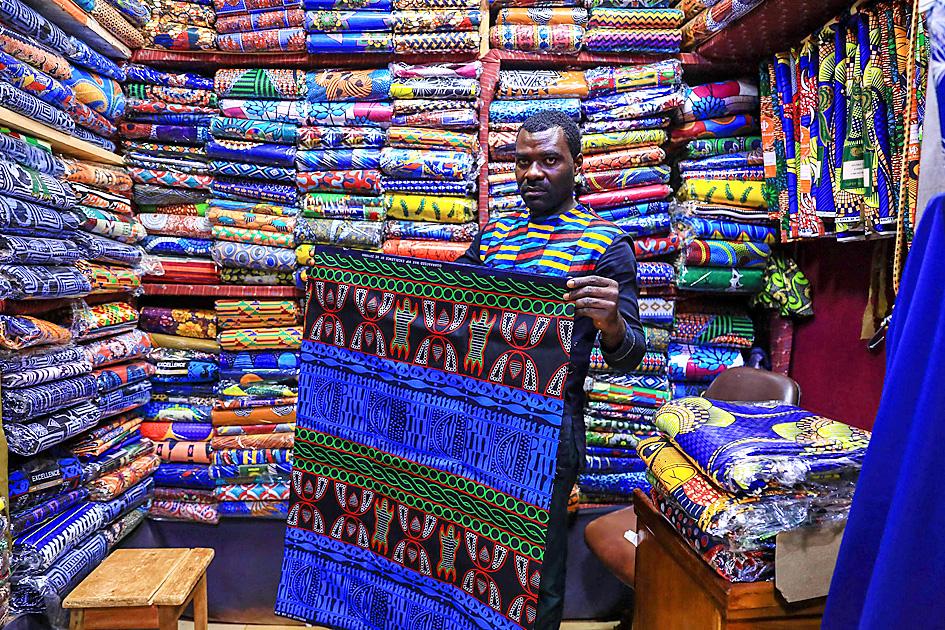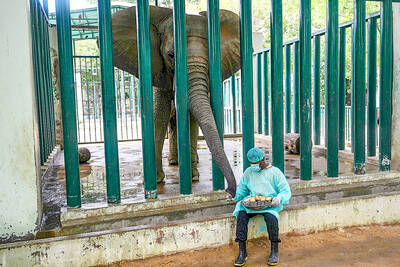Wambesso Fankam stands out elegantly from the crowd at a funeral ceremony in western Cameroon.
As a prince, he is among a select few who are traditionally entitled to wear an eye-catching fabric of vivid indigo with intricate white patterns.
“It’s an ndop, not everyone can wear it,” he said with pride, to the beat of tam-tam drums and the balafon, a type of xylophone, in the western town of Batie.

Photo: AFP
The ceremonial cloth was once the preserve of chiefs, dignitaries and members of secret societies in the central African country.
However, the culture around it is now being threatened by cheap imitations and crude rip-offs.
Ndop’s distinctive motifs — often animals or geometric shapes — are drawn on cotton fabric then embroidered with raphia before the material is dyed blue.

Photo: AFP
Its richness is down to the many different combinations of symbols that can be designed on the ndop.
Cameroon is thought to have 13,500 traditional chiefdoms across its 10 regions.
It is the north and the mountains of the west where chiefs are seen as all but divine guardians of tradition that the ndop culture is the strongest.
Once warlords and masters of justice, these days chiefs’ powers are limited to inheritance or matrimonial disputes.
Even so ndop is “the most important ritual element” among the main western tribal group, the Bamileke, said Hermann Yongueu, head of the Sauvons le Ndop (Save the Ndop) group, which is trying to preserve its heritage.
Making the cloth is a costly affair that takes several days’ work and requires specialized knowledge.
Prices for a piece of ndop cloth can go up to 100,000 West African francs (US$160) — a small fortune in Cameroon where one-third of the population lives on less than US$2 a day.
In Batie, an ndop cloth is symbolically hung on a wooden fence at the main entrance to the funeral.
One woman is wearing a long dress entirely in ndop.
“She is one of the few to wear an ndop outfit because she is a queen,” said Gisele Monkam, who accompanies the traditional chief.
Ndop mostly features “drawings that symbolize our way of life,” said Arsene Ngandjouong, head of a museum in the village of Bangoua in the west of the country.
One of the principal motifs is “a circle which represents the duality of the Bamileke world, a communication between the living and the dead,” Ngandjouong said.
Sitting near the door of her house made of baked mud bricks in Baham, the main town high on the western plateau where ndop is still made, craftswoman Solange Yougo, 52, is busy on a piece of fabric she has been working on for more than a week.
Making ndop is extremely laborious, with some long pieces measuring up to 15m taking up to a month to complete.
“I’m adding the finishing touches,” she said.
The finished item would be white with an indigo tint.
On a bamboo bench, her cousin Sylvie Momo, 50, holds an already dyed piece.
The Cameroonian Ministry of Arts and Culture declared ndop a part of its official national heritage in February 2020 and some also want it to be given UNESCO status as further protection.
While it was once strictly reserved for royals and nobles, ndop has been fast losing its exclusivity, so much so that some of its motifs are now turning up on bottles of beer, as well as low quality wraps and boubous, the loose unisex garment popular across west Africa.
“It is even becoming a bit vulgar,” Ngandjouong said.
“In the past when someone who hadn’t the right to wear ndop wore it, they had to pay a fine,” Fankam said.
“The most important thing is that we pass on knowledge of how to make it,” Yongueu said. “Before ndop fabric was controlled by the chiefs and the kings made sure that the savoir faire was passed on to the makers’ children. From the age of seven, children began their apprenticeships.”
However, few young people are prepared to take that on, preferring more lucrative jobs.
Others hope that a little of the reflected glory the fabric is picking up abroad might tempt them back, with the French luxury fashion house Hermes using ndop motifs in one of its silk scarf collections four years ago.

NO EXCUSES: Marcos said his administration was acting on voters’ demands, but an academic said the move was emotionally motivated after a poor midterm showing Philippine President Ferdinand Marcos Jr yesterday sought the resignation of all his Cabinet secretaries, in a move seen as an attempt to reset the political agenda and assert his authority over the second half of his single six-year term. The order came after the president’s allies failed to win a majority of Senate seats contested in the 12 polls on Monday last week, leaving Marcos facing a divided political and legislative landscape that could thwart his attempts to have an ally succeed him in 2028. “He’s talking to the people, trying to salvage whatever political capital he has left. I think it’s

Polish presidential candidates offered different visions of Poland and its relations with Ukraine in a televised debate ahead of next week’s run-off, which remains on a knife-edge. During a head-to-head debate lasting two hours, centrist Warsaw Mayor Rafal Trzaskowski, from Polish Prime Minister Donald Tusk’s governing pro-European coalition, faced the Eurosceptic historian Karol Nawrocki, backed by the right-wing populist Law and Justice party (PiS). The two candidates, who qualified for the second round after coming in the top two places in the first vote on Sunday last week, clashed over Poland’s relations with Ukraine, EU policy and the track records of their

UNSCHEDULED VISIT: ‘It’s a very bulky new neighbor, but it will soon go away,’ said Johan Helberg of the 135m container ship that run aground near his house A man in Norway awoke early on Thursday to discover a huge container ship had run aground a stone’s throw from his fjord-side house — and he had slept through the commotion. For an as-yet unknown reason, the 135m NCL Salten sailed up onto shore just meters from Johan Helberg’s house in a fjord near Trondheim in central Norway. Helberg only discovered the unexpected visitor when a panicked neighbor who had rung his doorbell repeatedly to no avail gave up and called him on the phone. “The doorbell rang at a time of day when I don’t like to open,” Helberg told television

A team of doctors and vets in Pakistan has developed a novel treatment for a pair of elephants with tuberculosis (TB) that involves feeding them at least 400 pills a day. The jumbo effort at the Karachi Safari Park involves administering the tablets — the same as those used to treat TB in humans — hidden inside food ranging from apples and bananas, to Pakistani sweets. The amount of medication is adjusted to account for the weight of the 4,000kg elephants. However, it has taken Madhubala and Malika several weeks to settle into the treatment after spitting out the first few doses they